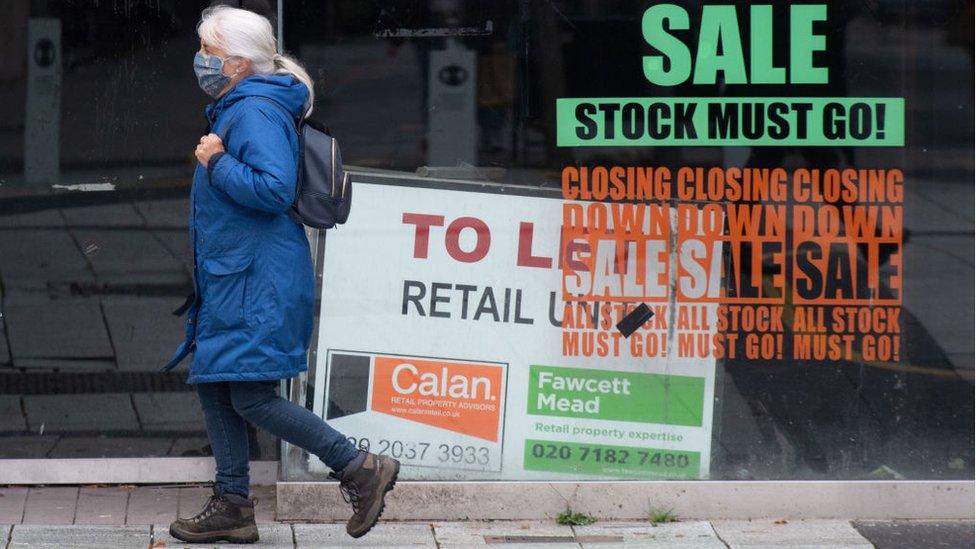Coronavirus: NI unemployment rate in biggest quarterly rise since 2012
- Published
- comments

Almost 2,000 redundancies were confirmed in NI in the last three months
Northern Ireland's unemployment rate has seen its largest quarterly increase since October 2012 - rising to 3.7%.
There were almost 2,000 confirmed redundancies in the past three months, according to official figures.
Employers must notify the department when making 20 or more employees redundant.
However, the figure doesn't include those making fewer than 20 staff redundant, so is likely to be an underestimate.
In the six weeks from September to mid October, employers proposed laying off 1,720 staff.
There is a time lag between the proposed and confirmed redundancies as employers must give 30 days notice for between 20 and 99 redundancies and 90 days notice for more than 100 redundancies.

There was a 1.7% fall in the number of paid employees in NI between March and April
Over the latest 12-month period there were 8,860 proposed redundancies, an increase of 90% from the previous year and the second highest annual total since comparable records began.
The redundancies were in sectors like manufacturing, retail and transport.
"The unemployment in Northern Ireland is still below the UK level overall, but more worryingly long-term unemployment is much higher - approximately 35% of all unemployed have been out of work for more than a year compared to just about 16% in the UK," said Gareth Hetherington, director of Ulster University's economic policy centre.
"That is important because people who are out of work for a long period of time it's hard for them to get back into work and into the labour market."
Estimates suggest about 20% of people placed on the government's furlough scheme still remain on it, Mr Heatherington told BBC Radio Foyle.
"Without a replacement for the job retention scheme, one would be very concerned about the prospects for those returning to work in November," he added.


More than six months on from the start of the pandemic, we are starting to get used to these startling unemployment statistics.
It's important to point out that all of these figures relate to a time when there is unprecedented levels of government support.
The government is paying the wages of tens of thousands of workers on the job retention scheme, which comes to an end this month.
Economists warn this trend is only likely to worsen and business groups fear rising numbers of Covid cases will lead to a further tightening of restrictions which will kill job losses.
Last week Economy Minister Diane Dodds said the department is forecasting that 100,000 people in Northern Ireland could be claiming unemployment related benefits by the end of this year.
It's now feared that may be at the "more optimistic" end of the predictions as to how many jobs are at risk before the end of the year.

A total of 62,000 people in Northern Ireland were claiming unemployment related benefits in October - more than double the figure in March, but unchanged from September.
This is the fifth month in a row with more than 60,000 claimants and is similar to levels seen in 2012 and 2013.
The unemployment rate was 3.7% between June and August, which is 1.2% higher than the previous quarter and relates to a time when thousands of people in NI were still on the government's job retention scheme.
New data from Her Majesty's Revenue and Customs, released for the first time for Northern Ireland on Tuesday, shows a 1.7% fall in the number of paid employees between March and April.
Since then, there has been a small increase in the number of paid employees, but the September total remains 1.3% lower than in March.
The youth (16-24) unemployment rate was 11.8% but the rate is based on a smaller sample which may result in less precise estimates and should be used with caution when comparing with other regions.
'Difficult for foreseeable future'
Speaking to Radio Ulster's Good Morning Ulster programme, Dr Michael Malone of South Eastern Regional College (SERC) said students are "well aware" the labour market is going to be difficult "for the foreseeable future".
"Certain sectors have been more difficult than others - catering and hospitality has been particularly affected, whereas other areas, such as pharmacy, remain completely unaffected.
"All the colleges have a significant part to play in the economic regeneration that needs to take place after Covid and even as Covid starts to play out."
Despite the figures, Dr Malone said students remain "very optimistic" about their career choices.
- Published13 October 2020

- Published16 November 2021

- Published30 September 2021
